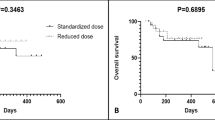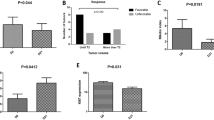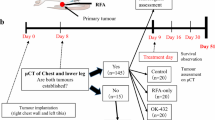Abstract
On the basis of superior outcomes from electrochemogenetherapy (ECGT) compared with electrochemotherapy in mice, we determined the efficacy of ECGT applied to spontaneous canine neoplasms. Intralesional bleomycin (BLM) and feline interleukin-12 DNA injection combined with translesional electroporation resulted in complete cure of two recurrent World Health Organization stage T2bN0M0 oral squamous cell carcinomas (SCCs) and one T2N0M0 acanthomatous ameloblastoma. Three remaining dogs, which had no other treatment options, had partial responses to ECGT; one had mandibular T3bN2bM1 melanoma with pulmonary and lymph node metastases; one had cubital T3N0M1 histiocytic sarcoma with spleen metastases; and one had soft palate T3N0M0 fibrosarcoma. The melanoma dog had decrease in the size of the primary tumor before recrudescence and euthanasia. The histiocytic sarcoma dog had resolution of the primary tumor, but was euthanized because of metastases 4 months after the only treatment. The dog with T3N0M0 fibrosarcoma had tumor regression with recrudescence. Treatment was associated with minimal side effects and was easy to perform, was associated with repair of bone lysis in cured dogs, improved quality of life for dogs with partial responses and extended overall survival time. ECGT seems to be a safe and resulted in complete responses in SCC and acanthomatous ameloblastoma.
This is a preview of subscription content, access via your institution
Access options
Subscribe to this journal
Receive 12 print issues and online access
$259.00 per year
only $21.58 per issue
Buy this article
- Purchase on Springer Link
- Instant access to full article PDF
Prices may be subject to local taxes which are calculated during checkout






Similar content being viewed by others
References
Mir LM . Application of electroporation gene therapy: past, current, and future. Methods Mol Biol 2008; 423: 3–17.
Miyazaki M, Obata Y, Abe K, Furusu A, Koji T, Tabata Y et al. Gene transfer using nonviral delivery systems. Perit Dial Int 2006; 26: 633–640.
Teissie J, Golzio M, Rols MP . Mechanisms of cell membrane electropermeabilization: a minireview of our present (lack of ?) knowledge. Biochim Biophys Acta 2005; 1724: 270–280.
Gehl J . Electroporation: theory and methods, perspectives for drug delivery, gene therapy and research. Acta Physiol Scand 2003; 177: 437–447.
Reed SD, Li S . Electroporation advances in large animals. Curr Gene Ther 2009; 9: 316–326.
Sammeta SM, Vaka SR, Narasimha Murthy S . Transdermal drug delivery enhanced by low voltage electropulsation (LVE). Pharm Dev Technol 2009; 14: 159–164.
Barbul A, Antov Y, Rosenberg Y, Korenstein R . Enhanced delivery of macromolecules into cells by electroendocytosis. Methods Mol Biol 2009; 480: 141–150.
Campana LG, Mocellin S, Basso M, Puccetti O, De Salvo GL, Chiarion-Sileni V et al. Bleomycin-based electrochemotherapy: clinical outcome from a single institution's experience with 52 patients. Ann Surg Oncol 2009; 16: 191–199.
Cemazar M, Tamzali Y, Sersa G, Tozon N, Mir LM, Miklavcic D et al. Electrochemotherapy in veterinary oncology. J Vet Intern Med 2008; 22: 826–831.
Qian C, Liu XY, Prieto J . Therapy of cancer by cytokines mediated by gene therapy approach. Cell Res 2006; 16: 182–188.
Lollini PL, De Giovanni C, Pannellini T, Cavallo F, Forni G, Nanni P . Cancer immunoprevention. Future Oncol 2005; 1: 57–66.
Mortara L, Giuliani L, De Lerma Barbaro A, Accolla RS, Noonan DM . Experimental therapeutic approaches to adenocarcinoma: the potential of tumor cells engineered to express MHC class II molecules combined with naked DNA interleukin-12 gene transfer. Surg Oncol 2007; 16 (Suppl 1): S33–S36.
Weiss JM, Subleski JJ, Wigginton JM, Wiltrout RH . Immunotherapy of cancer by IL-12-based cytokine combinations. Expert Opin Biol Ther 2007; 7: 1705–1721.
Mazzolini G, Prieto J, Melero I . Gene therapy of cancer with interleukin-12. Curr Pharm Des 2003; 9: 1981–1991.
Persano L, Crescenzi M, Indraccolo S . Anti-angiogenic gene therapy of cancer: current status and future prospects. Mol Aspects Med 2007; 28: 87–114.
Daud AI, DeConti RC, Andrews S, Urbas P, Riker AI, Sondak VK et al. Phase I trial of interleukin-12 plasmid electroporation in patients with metastatic melanoma. J Clin Oncol 2008; 26: 5896–5903.
Torrero MN, Henk WG, Li S . Regression of high-grade malignancy in mice by bleomycin and interleukin-12 electrochemogenetherapy. Clin Cancer Res 2006; 12: 257–263.
Takimoto CH CE . Principles of oncologic pharmacotherapy. In: Pazdur R WL, Camphausen KA, Hoskins WJ, (edn). Cancer Management: A Multidisciplinary Approach. 11 ed. 2008.
Spugnini EP, Vincenzi B, Citro G, Tonini G, Dotsinsky I, Mudrov N et al. Electrochemotherapy for the treatment of squamous cell carcinoma in cats: a preliminary report. Vet J 2009; 179: 117–120.
Gothelf A, Mir LM, Gehl J . Electrochemotherapy: results of cancer treatment using enhanced delivery of bleomycin by electroporation. Cancer Treat Rev 2003; 29: 371–387.
Kishida T, Asada H, Itokawa Y, Yasutomi K, Shin-Ya M, Gojo S et al. Electrochemo-gene therapy of cancer: intratumoral delivery of interleukin-12 gene and bleomycin synergistically induced therapeutic immunity and suppressed subcutaneous and metastatic melanomas in mice. Mol Ther 2003; 8: 738–745.
Buttner M, Belke-Louis G, Rziha HJ, McInnes C, Kaaden OR . Detection, cDNA cloning and sequencing of canine interleukin 12. Cytokine 1998; 10: 241–248.
Ehrhart N . Soft-tissue sarcomas in dogs: a review. J Am Anim Hosp Assoc 2005; 41: 241–246.
Khanna C, Lindblad-Toh K, Vail D, London C, Bergman P, Barber L et al. The dog as a cancer model. Nat Biotechnol 2006; 24: 1065–1066.
Cutrera J, Torrero M, Shiomitsu K, Mauldin N, Li S . Intratumoral bleomycin and IL-12 electrochemogenetherapy for treating head and neck tumors in dogs. Met Mol Biol 2008; 423: 319–325.
Acknowledgements
We thank Dr Steve Dunham, Associate Professor of Veterinary Virology of the University of Nottingham School of Veterinary Medicine and Science, for providing the fIL-12 construct and Invio, Incorporated for providing the electroporation electrode. SDR was supported by the National Institutes of Health under Ruth L Kirschstein T-32 National Research Service Award during the production of this paper. This research was supported by NIH/NCI 5RO1CA120895.
Author information
Authors and Affiliations
Corresponding author
Ethics declarations
Competing interests
The authors declare no conflict of interest.
Rights and permissions
About this article
Cite this article
Reed, S., Fulmer, A., Buckholz, J. et al. Bleomycin/interleukin-12 electrochemogenetherapy for treating naturally occurring spontaneous neoplasms in dogs. Cancer Gene Ther 17, 571–578 (2010). https://doi.org/10.1038/cgt.2010.13
Received:
Revised:
Accepted:
Published:
Issue Date:
DOI: https://doi.org/10.1038/cgt.2010.13
Keywords
This article is cited by
-
CD8+T cell–specific induction of NKG2D receptor by doxorubicin plus interleukin-12 and its contribution to CD8+T cell accumulation in tumors
Molecular Cancer (2014)
-
The anti-tumor drug bleomycin preferentially cleaves at the transcription start sites of actively transcribed genes in human cells
Cellular and Molecular Life Sciences (2014)
-
Electroporation increases antitumoral efficacy of the bcl-2 antisense G3139 and chemotherapy in a human melanoma xenograft
Journal of Translational Medicine (2011)
-
The function of dog models in developing gene therapy strategies for human health
Mammalian Genome (2011)



